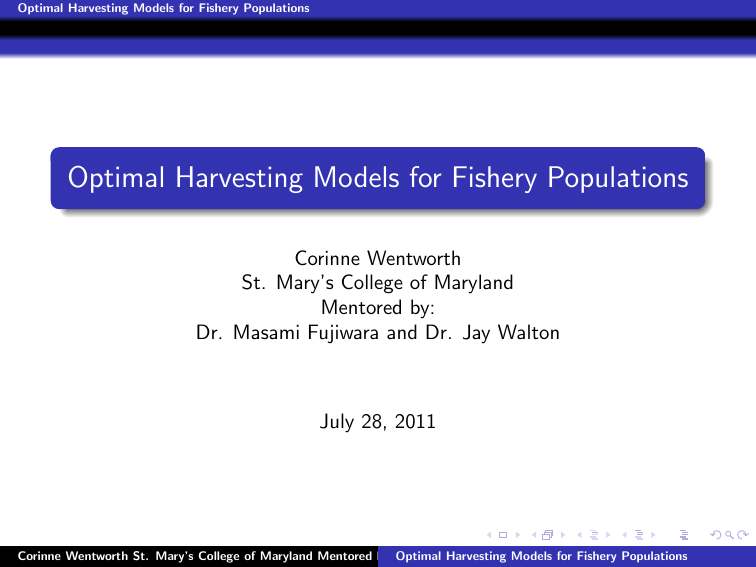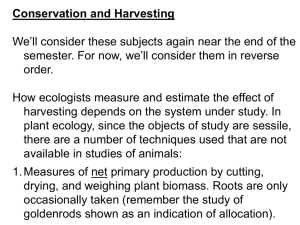Optimal Harvesting Models for Fishery Populations
advertisement

Optimal Harvesting Models for Fishery Populations Optimal Harvesting Models for Fishery Populations Corinne Wentworth St. Mary’s College of Maryland Mentored by: Dr. Masami Fujiwara and Dr. Jay Walton July 28, 2011 Corinne Wentworth St. Mary’s College of Maryland Mentored by: Optimal Dr. Masami Harvesting Fujiwara Models and Dr. for Jay Fishery Walton Populations Optimal Harvesting Models for Fishery Populations Introduction Outline 1 Introduction 2 Population models 3 Analysis Equilibrium vs. transient Initial conditions 4 Continuation of research Corinne Wentworth St. Mary’s College of Maryland Mentored by: Optimal Dr. Masami Harvesting Fujiwara Models and Dr. for Jay Fishery Walton Populations Optimal Harvesting Models for Fishery Populations Introduction Motivation Fish worldwide are at varying population levels Healthy Declining Endangered Dilemma: Economy demands fish for food Ecologically important to keep populations intact What is fishery management? The study of fish populations under harvesting strategies Corinne Wentworth St. Mary’s College of Maryland Mentored by: Optimal Dr. Masami Harvesting Fujiwara Models and Dr. for Jay Fishery Walton Populations Optimal Harvesting Models for Fishery Populations Introduction Research We have been investigating: 1 Keeping a population stable 2 Harvesting under different rates (some time dependent) Problem: How can we maximize yield without endangering population sustainability? Corinne Wentworth St. Mary’s College of Maryland Mentored by: Optimal Dr. Masami Harvesting Fujiwara Models and Dr. for Jay Fishery Walton Populations Optimal Harvesting Models for Fishery Populations Introduction Allee effect Definition In population dynamics an Allee effect occurs when there is a positive correlation between population density n(t) and population growth rate dn dt . When the population is small there is a penalty on reproduction Hard for individuals to find mates Leads to smaller growth rate Corinne Wentworth St. Mary’s College of Maryland Mentored by: Optimal Dr. Masami Harvesting Fujiwara Models and Dr. for Jay Fishery Walton Populations Optimal Harvesting Models for Fishery Populations Population Models Single stage models We will consider three models: 1 Simple logsitic model dn dt = n(1 − n) − fn 2 Skewed logistic model dn 2 dt = n (1 − n) − fn 3 Allee effect model dn dt = n(n − a)(1 − n) − fn where n is fish population, f is harvest rate, and 0 < a < 1 is a constant (Allee effect). For each model we found the equilibrium solution. We have also determined the harvest rate that maximizes yield. Corinne Wentworth St. Mary’s College of Maryland Mentored by: Optimal Dr. Masami Harvesting Fujiwara Models and Dr. for Jay Fishery Walton Populations Optimal Harvesting Models for Fishery Populations Population Models Harvesting strategies We will consider two harvesting strategies: 1 Constant harvesting 2 Time dependent harvesting f is a function of time Corinne Wentworth St. Mary’s College of Maryland Mentored by: Optimal Dr. Masami Harvesting Fujiwara Models and Dr. for Jay Fishery Walton Populations Optimal Harvesting Models for Fishery Populations Population Models A constant harvesting strategy Harvest at a rate 0 < f < 1 each time unit. Corinne Wentworth St. Mary’s College of Maryland Mentored by: Optimal Dr. Masami Harvesting Fujiwara Models and Dr. for Jay Fishery Walton Populations Optimal Harvesting Models for Fishery Populations Population Models A time dependent harvesting strategy In theory we could harvest at any function of t Impractical to implement Simplified strategy: ( f1 : 0 < t < T2 f (t) = f2 : T2 < t ≤ T so we harvest for time T at two constant rates. Corinne Wentworth St. Mary’s College of Maryland Mentored by: Optimal Dr. Masami Harvesting Fujiwara Models and Dr. for Jay Fishery Walton Populations Optimal Harvesting Models for Fishery Populations Population Models Yield How do we calculate yield from the harvesting function? Z Y := T fn(t)dt 0 Corinne Wentworth St. Mary’s College of Maryland Mentored by: Optimal Dr. Masami Harvesting Fujiwara Models and Dr. for Jay Fishery Walton Populations Optimal Harvesting Models for Fishery Populations Analysis Analysis of models Classical approach: Find equilibrium solution Determine yield Transient approach: Fix parameters (initial conditions, time) Find harvest rate that maximizes yield Corinne Wentworth St. Mary’s College of Maryland Mentored by: Optimal Dr. Masami Harvesting Fujiwara Models and Dr. for Jay Fishery Walton Populations Optimal Harvesting Models for Fishery Populations Analysis Equilibrium Definition An equilibrium is stable if the system returns to equilibrium after small disturbances. Otherwise, if the system moves away from equilibrium after small disturbances then the equilibrum is unstable. Let n∗ , f ∗ , and Y ∗ be population density, harvest rate, and yield at equilibrium. Corinne Wentworth St. Mary’s College of Maryland Mentored by: Optimal Dr. Masami Harvesting Fujiwara Models and Dr. for Jay Fishery Walton Populations Optimal Harvesting Models for Fishery Populations Analysis: Simple Logistic Simple logistic model - equilibrium dn dt = n(1 − n) − fn Solution: n∗ = 1 2 f∗ = 1 2 Y∗ = 1 4 Corinne Wentworth St. Mary’s College of Maryland Mentored by: Optimal Dr. Masami Harvesting Fujiwara Models and Dr. for Jay Fishery Walton Populations Optimal Harvesting Models for Fishery Populations Analysis: Simple Logistic Simple logistic solution Equilibrium population denisity is half of the carrying capacity Corinne Wentworth St. Mary’s College of Maryland Mentored by: Optimal Dr. Masami Harvesting Fujiwara Models and Dr. for Jay Fishery Walton Populations Optimal Harvesting Models for Fishery Populations Analysis: Simple Logistic Simple logistic - transient (time) Yield as a function of harvest rate over various times: Initial population n0 = 1 Corinne Wentworth St. Mary’s College of Maryland Mentored by: Optimal Dr. Masami Harvesting Fujiwara Models and Dr. for Jay Fishery Walton Populations Optimal Harvesting Models for Fishery Populations Analysis: Simple Logistic Simple logistic - transient (initial conditions) Yield as a function of harvest rate for varying initial populations: Time T = 10 Corinne Wentworth St. Mary’s College of Maryland Mentored by: Optimal Dr. Masami Harvesting Fujiwara Models and Dr. for Jay Fishery Walton Populations Optimal Harvesting Models for Fishery Populations Analysis: Simple Logistic Problems with simple logistic model Problem: Simple logistic model has no reproductive penalty Reproductive rate is the same regardless of population size Solution: Add a square term to the model giving us skewed logistic model dn = n2 (1 − n) − fn dt Corinne Wentworth St. Mary’s College of Maryland Mentored by: Optimal Dr. Masami Harvesting Fujiwara Models and Dr. for Jay Fishery Walton Populations Optimal Harvesting Models for Fishery Populations Analysis: Skewed Logistic Skewed logistic model - equilibrium dn dt = n2 (1−n)−fn Solution: n∗ = 2 3 f∗ = 2 9 Y∗ = 4 27 Corinne Wentworth St. Mary’s College of Maryland Mentored by: Optimal Dr. Masami Harvesting Fujiwara Models and Dr. for Jay Fishery Walton Populations Optimal Harvesting Models for Fishery Populations Analysis: Skewed Logistic Skewed logistic - transient (time) Yield as a function of harvest rate over various times: Initial population n0 = 1 Corinne Wentworth St. Mary’s College of Maryland Mentored by: Optimal Dr. Masami Harvesting Fujiwara Models and Dr. for Jay Fishery Walton Populations Optimal Harvesting Models for Fishery Populations Analysis: Skewed Logistic Skewed logistic - transient (initial conditions) Yield as a function of harvest rate for varying initial populations: Time T = 10 Corinne Wentworth St. Mary’s College of Maryland Mentored by: Optimal Dr. Masami Harvesting Fujiwara Models and Dr. for Jay Fishery Walton Populations Optimal Harvesting Models for Fishery Populations Analysis: Allee effect Allee effect model How can we increase the penalty on reproduction? Add Allee effect As 0 < a < 1 increases penalty on reproduction increases Corinne Wentworth St. Mary’s College of Maryland Mentored by: Optimal Dr. Masami Harvesting Fujiwara Models and Dr. for Jay Fishery Walton Populations Optimal Harvesting Models for Fishery Populations Analysis: Allee effect Allee effect solution Corinne Wentworth St. Mary’s College of Maryland Mentored by: Optimal Dr. Masami Harvesting Fujiwara Models and Dr. for Jay Fishery Walton Populations Optimal Harvesting Models for Fishery Populations Analysis: Allee effect Allee effect model - equilibrium dn = n(n − a)(1 − n) − fn dt There are two equilibria: n1∗ is unstable - population will go to extinction n2∗ is stable Corinne Wentworth St. Mary’s College of Maryland Mentored by: Optimal Dr. Masami Harvesting Fujiwara Models and Dr. for Jay Fishery Walton Populations Optimal Harvesting Models for Fishery Populations Analysis: Allee effect Allee effect model: 1 2 dn dt = n(n − a)(1 − n) − fn 2 If f ≥ 1+a as 2 t → ∞, n(t) decreases to extinction 2 Given f < 1+a 2 If n0 < n1∗ , n(t) decreases to extinction If n0 > n1∗ , n(t) increases to n2∗ 3 Given n0 If f > (n0 − a)(1 − n0 ), n(t) decreases to extinction ⇒ f ≤ (n0 − a)(1 − n0 ) Corinne Wentworth St. Mary’s College of Maryland Mentored by: Optimal Dr. Masami Harvesting Fujiwara Models and Dr. for Jay Fishery Walton Populations Optimal Harvesting Models for Fishery Populations Analysis: Allee effect Allee effect model Harvest vs. yield for various 0 < a < 1 Corinne Wentworth St. Mary’s College of Maryland Mentored by: Optimal Dr. Masami Harvesting Fujiwara Models and Dr. for Jay Fishery Walton Populations Optimal Harvesting Models for Fishery Populations Analysis: Allee effect Allee effect - transient (time) Yield as a function of harvest rate over various times: Allee effect a = 0.1 Initial population n0 = 1 Corinne Wentworth St. Mary’s College of Maryland Mentored by: Optimal Dr. Masami Harvesting Fujiwara Models and Dr. for Jay Fishery Walton Populations Optimal Harvesting Models for Fishery Populations Analysis: Allee effect Allee effect - transient (initial conditions) Yield as a function of harvest rate for varying initial populations: a = 0.1 Time T = 10 Corinne Wentworth St. Mary’s College of Maryland Mentored by: Optimal Dr. Masami Harvesting Fujiwara Models and Dr. for Jay Fishery Walton Populations Optimal Harvesting Models for Fishery Populations Analysis: Initial Conditions What role do initial conditions play? Let n(0) = n0 denote inital population density. Allee effect - if n0 < a the population goes extinct with constant harvesting. Healthy population - if the population is healthy, then constant and time dependent strategies give same yield. Unhealthy - if the population is unhealthy, ie. n0 is small (less than equilibrium) then a time dependent harvesting will vastly increase yield over constant. Corinne Wentworth St. Mary’s College of Maryland Mentored by: Optimal Dr. Masami Harvesting Fujiwara Models and Dr. for Jay Fishery Walton Populations Optimal Harvesting Models for Fishery Populations Continuation of Research Possible further studies 1 Expand these models to a two stage population with juvenilles and adults 2 Construct models that include life history strategies of fish 3 Optimization problem with two stage harvest function 4 Implement harvest functions with more than two stages Corinne Wentworth St. Mary’s College of Maryland Mentored by: Optimal Dr. Masami Harvesting Fujiwara Models and Dr. for Jay Fishery Walton Populations





